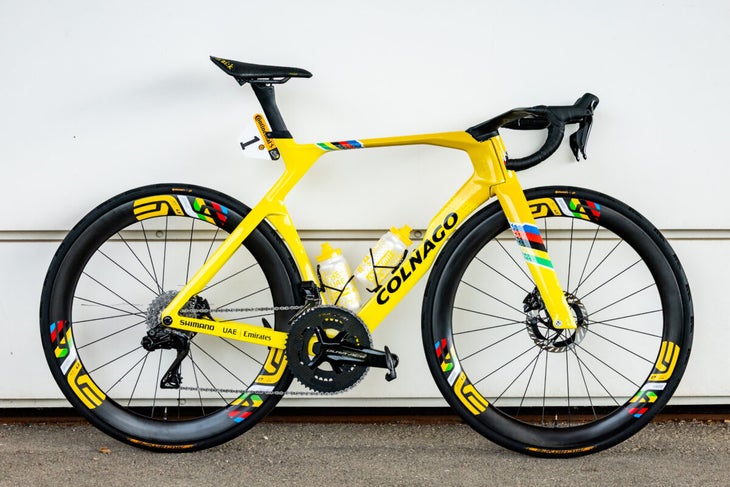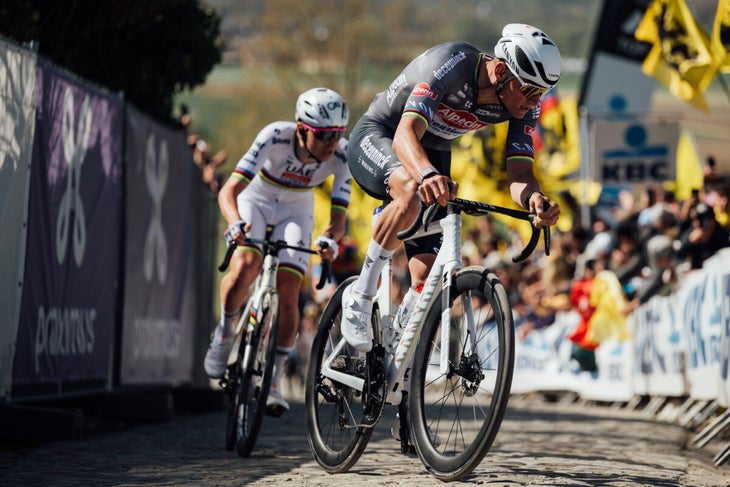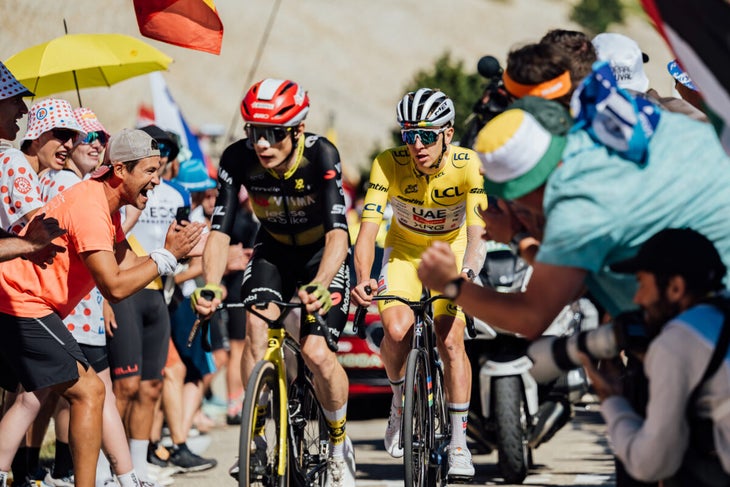“], “filter”: { “nextExceptions”: “img, blockquote, div”, “nextContainsExceptions”: “img, blockquote, a.btn, a.o-button”} }”>
Tadej Pogačar won his fourth Tour de France thanks to a bunch of resistance bands and a yoga mat.
Insiders at UAE Emirates-XRG revealed how the outrageous seated accelerations Pogačar used to obliterate Jonas Vingegaard on the Hautacam and beat back Visma-Lease a Bike in the Alps were forged in the gym.
“Core training is a big part of Tadej’s ability to stay seated when he attacks with his shorter cranks,” team performance coordinator Jeroen Swart told L’Equipe.
“Pedaling at a higher frequency is beneficial when seated,” Swart said. “Strengthening the core is needed to do this.”
Pogačar landed into, and then defended, his fourth yellow jersey in his saddle.
The 26-year-old wreaked havoc with a hyper-cadence seated acceleration that blew away Vingegaard and Visma while they stood mashing in the pedals.
The new trademark move was made possible by Pogačar becoming a gym bro.
“When you’re seated, you have to rely on force from holding the pelvis steady,” Swart said. “If you can create more stability by having done more strength work, you can do that for longer.
“That means when Tadej is attacking in the saddle, he’s still got some physiological reserve. He can then use that by getting out of the saddle,” Swart told Dan Lloyd in a recent video on the Global Cycling Network
Pogačar and his short crank, high cadence, core training era
 Pogačar’s Tour de France Y1RS, complete with 165mm cranks. (Photo: Leon Van Bon and Fizza/Colnago)
Pogačar’s Tour de France Y1RS, complete with 165mm cranks. (Photo: Leon Van Bon and Fizza/Colnago)
Pogačar’s all-seated attacks became a trend since the appointment of his new trainer Javier Sola in early 2024.
The Spanish staffer shook up Pogi’s performance program by increasing the focus on strength work and heat training, and tilting the balance on his intervals.
Parallel to that, Pogačar and team biomechanist David Herrero gambled on the much-discussed downsize to 165mm cranks.
It was a bike fitting tweak to achieve a more aggressive, mechanically safer bike position.
The offset? Pogi would need to spin faster for peak power – something most easily achieved in the saddle.
Tadej Pogacar made Hautacam look like Cipressa, after an epic leadout by the same Johnny Narvaez. Vingegaard didn’t stand a chance. Fair to say that yesterday’s crash didn’t affect him at all, good to see but hope the Tour isn’t over.#TDF2025 pic.twitter.com/bRU8oGwCqO
— Mihai Simion (@faustocoppi60) July 17, 2025
The peloton has been swinging in the pedals ever since Pogačar shaved multiple millimeters from his crank arms.
Herrero and Sola hotwired Pogačar into a demolition derby that’s run through the Giro d’Italia, two Tours de France, countless monuments, and the road worlds.
Strength and weight for the spring classics
 Pogačar hit the gym more in preparation for the classics. (Photo: Chris Auld / Velo)
Pogačar hit the gym more in preparation for the classics. (Photo: Chris Auld / Velo)
Pogačar’s buzzsawing surges became more evident than ever this season.
Pogačar was planted solid on top of his saddle while he tore the legs off Tom Pidcock in March at Strade Bianche. There were similar scenes one month later when he dropped Mads and MVDP at the Tour of Flanders.
Vingegaard was the next victim. Pogačar deployed his vicious 110rpm+ accelerations to devastating effect this summer at the Critérium du Dauphiné and Tour de France.
Pogačar’s new preference for seated power appears a byproduct of his quest to crush the cobblestones of spring.
The Tour of Flanders and Paris-Roubaix are won with high-torque seated efforts that provide traction over slick stones.
“The biggest change for Tadej this year was his schedule,” Swart said of Pogačar’s monument ambition.
“We focused first on gaining muscle mass because one-day races require more explosiveness,” Swart told L’Equipe. “He didn’t lose weight, and did more strength work. And he started his mountain sessions later in the season.”
In early 2024, Pogačar was stripping weight and climbing mountains in advance of the Giro d’Italia.
This winter, Pogi took his rainbow stripes to the strength center.
How to train like a pro during off season, Tadej Pogacar edition pic.twitter.com/VRCrbQbE7Q
— Domestique (@Domestique___) December 4, 2024
Built in the weights room, practiced with torque intervals
Pogačar has been working with S&C coach Alexandre Bacilli, the VIP practitioner to Monaco’s sporting millionaires, for several years.
The strength guru rolled out a conditioning regime for Pogačar that targets every cobbles-crushing micro-muscle.
Behind-the-scenes reels show how the Bosu balls, resistance bands, and blood-flow restriction straps of “Project Six Pack” became as important to Pogi as his head unit and power meter.
But bike races aren’t won in the weight room alone.
Pogačar realized his gym gains with a renewed focus on the low-cadence torque intervals investigated here by Velo‘s pro training sleuth Zach Nehr.
“Functional strength is also doing strength work on the bike, such as low-cadence riding,” said UAE Emirates performance chief Swart. “Head units now measure newton meters, so it’s possible to do torque intervals.
“The mixture of torque and power intervals is important for optimal performance,” Swart said.
Why stay seated?
 Pogačar parried Visma-Lease a Bike’s attacks in the Alps from the seat. (Photo: Chris Auld / Velo)
Pogačar parried Visma-Lease a Bike’s attacks in the Alps from the seat. (Photo: Chris Auld / Velo)
Pogačar’s second victory at the Tour of Flanders and a near miss at Paris-Roubaix prove all those unsexy strength sessions paid off.
His cobbles-conditioned core paid big on the pavement, too. Just check out all his high-mountain KOMs from the Tour.
Seated accelerations are more aerobically and aerodynamically efficient on all surfaces.
“You have a lot more explosivity out of the saddle because you change the center of mass,” Swart explained.
“You’re able to generate a much higher force out of the seat, for a short time. But being out of the seat becomes pretty inefficient after 15-20 seconds.
“You can’t hold [a standing attack] for long because your oxygen cost goes up, and your drag increases because you have a higher frontal area,” Swart told GCN.
Pogačar’s standing attacks became the final, not the first, bullet in the chamber.
I remember the backlash I got when I first said that I think Pogačar has changed his attacking style, trading his explosive bursts for sustained 60- to 90-second efforts without even getting out of the saddle
Such an effective way to get separation♂️
— Inside Out (@InsideOut2912) June 13, 2025
Another benefit to a rock-solid core?
Team bike-fitter Herrero hailed Pogačar’s newfound strength and flexibility as crucial to him achieving a longer, lower time trial position.
Core strength: Another part of the Pogačar blueprint
 Want to pedal like Pogačar? Don’t skip your sit-ups. (Photo: Gruber Images / Velo)
Want to pedal like Pogačar? Don’t skip your sit-ups. (Photo: Gruber Images / Velo)
Of course, Pogačar’s 18-month obliteration of the WorldTour wasn’t only because he did a bunch of sit-ups and split squats.
A psoas of steel was the final enabler of a physiological freakery created from high-carb fueling, heat training, an optimized altitude program, and very good genes.
“There isn’t one factor, but five or six, without really knowing which one has more influence than another,” Swart said. “But all together, we can see this incredible improvement.”
So if you’re already eating 120g of carbohydrates per hour while spinning your micro-cranks in a “heat suit,” you better go sign up to a strength class, too.

